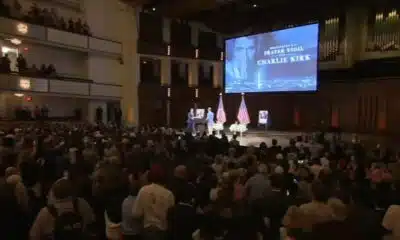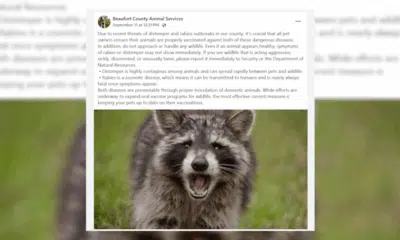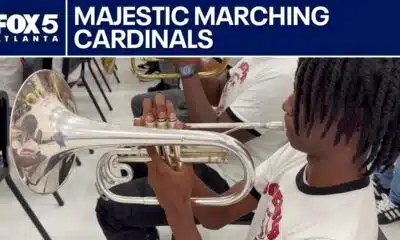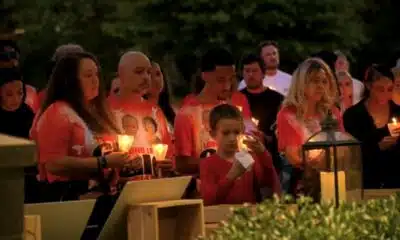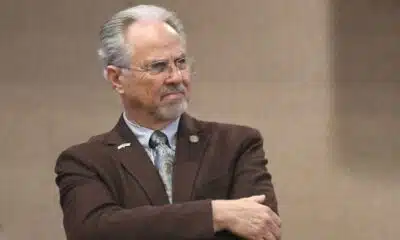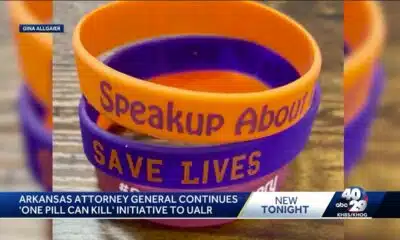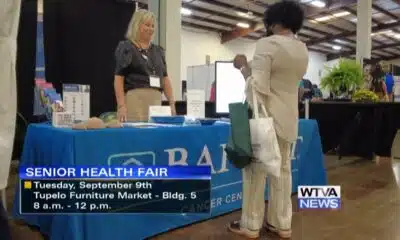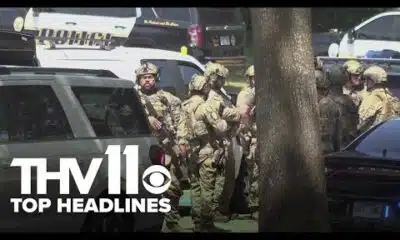News from the South - Virginia News Feed
Bagby’s omission of his wife, businesses on economic interest disclosure forms raise questions
Bagby’s omission of his wife, businesses on economic interest disclosure forms raise questions
by Charlotte Rene Woods, Virginia Mercury
March 18, 2025
Political officials in Virginia are required to submit Statement of Economic Interest forms that are posted to the state’s ethics advisory council website. As a part-time legislature, delegates and senators have lives and other work outside of representing constituents and must disclose publicly what might be an economic interest to them.
Sen. Lamont Bagby, D-Henrico, who is running to be the next chair of the Democratic Party of Virginia, initially failed to disclose his wife and various businesses on recent SOEI forms. Though the document has been amended to include those details, one of his opponents in the race questions why they weren’t revealed in the first place and if it’s something Republicans could target Bagby for should he become the leader of the state’s Democratic party.
Bagby told The Mercury that the omission was an “oversight.”
Potential liability for state Democrats?
The form includes the question “Do you or a member of your immediate family own, separately or together, a business that has a value in excess of $5,000?” Bagby had at first answered “no,” despite his wife’s salon and event space businesses. On the updated form, amended on March 10, he answered yes to that question.
Josh Stanfield, who is also running for DPVA chair, has tried to ask Bagby about potential conflicts of interest in candidate forums.
In an interview with the Mercury and on his blog, Stanfield noted that when former Democratic governor L. Douglas Wilder was a candidate in 1989, he came under scrutiny from Republicans for failing to disclose his real estate and stock holdings on forms. At the time, Wilder called on then-Democratic Attorney General Mary Sue Terry to investigate the matter.
“(She) was able to put that to rest,” Stanfield said. “But the point is, when it comes to these forms, any sort of omission or anything of serious question gives the Republicans a route of attack, whether founded or unfounded.”
Stanfield also points to Republican Attorney General Jason Miyares’ run for re-election and how former DPVA spokesperson Liam Watson was subject to a probe from Miyares’ office. Watson, who left DPVA in 2023 after being elected to Blacksburg town council, now faces trial for election fraud charges.
DPVA’s central committee members will vote between Zach Pruckowski, Bagby and Stanfield on March 22 to pick the party’s new chair. That person will then be the new face and voice of the political party in Virginia and can play a key role in boosting Democrats ahead of this year’s House of Delegates and executive branch elections.
The Democratic Party of Va. will pick a new leader this month. Here are the candidates’ platforms.
When reached for comment, Pruckowski did not wish to weigh in on Bagby’s forms.
“I’m just staying focused on making the case to members of (DPVA’s Central Committee) that I’m the best guy for the job,” he said.
As candidates for an inner-party race rather than a state-run election, neither Stanfield and Pruckowski are subject to the SOEI.
“To qualify for the ballot in a state-run election, you have to fill out to SOEI,” DPVA’s executive director Shyam Raman said.
Meanwhile, as a former state candidate and current state lawmaker, Bagby fills out SOEI forms each year. Issues with Bagby’s paperwork were first discovered by independent journalist Christa Motley and when she questioned Bagby about them, his lawyer responded.
“The omission that you shared has been addressed and was a result of an oversight,” Bagby’s lawyer Joe Massie wrote to Motley on March 11 after the forms had been updated.
Motley, who has spent years reporting on how Virginia’s substance use recovery homes are managed in the state, uncovered Bagby’s connections to the Virginia Association of Recovery Residences and began looking into his finances more closely when he announced his run for DPVA chair.
Her reporting on recovery homes revealed Bagby’s role in state funds that VARR has received in recent years — a role Bagby has downplayed.
“All I have done was give money to the recovery community,” he said in a recent interview with The Mercury.
Emails that Motley received through a Freedom of Information Act request showed VARR officials referring to Bagby as a “champion” in the legislature. He also joined a limited liability company called Imagine The Freedom LLC with members of VARR, which owned a property, as well. Though the LLC was on Bagby’s previous SOEI forms, it is absent in recent years. This is because his association with Imagine The Freedom has ended, he told The Mercury.
Virginia’s Conflict of Interest and Ethics Advisory Council website is where SOEI forms are publicly viewable. The database indicates that Bagby recently amended his filing, but previous versions of the forms are not publicly available. The Mercury confirmed the omissions through a records request to the council.
GET THE MORNING HEADLINES.
Virginia Mercury is part of States Newsroom, a nonprofit news network supported by grants and a coalition of donors as a 501c(3) public charity. Virginia Mercury maintains editorial independence. Contact Editor Samantha Willis for questions: info@virginiamercury.com.
The post Bagby’s omission of his wife, businesses on economic interest disclosure forms raise questions appeared first on virginiamercury.com
News from the South - Virginia News Feed
Some employers take action against employees for social media comments on Charlie Kirk's death
SUMMARY: Following Charlie Kirk’s death, some Virginia employers have taken action against employees who made controversial social media comments. In healthcare and education sectors, individuals were placed on leave or terminated for remarks deemed unprofessional or supportive of violence. Riverside Walter Reed Hospital fired an anesthesiologist, and Newport News and Accomack County schools disciplined staff members. Experts highlight the blurred line between personal expression and professional conduct due to social media’s reach. William and Mary law professor Margaret Hugh emphasized that employment laws and at-will policies allow employers broad authority to act. She urges unity and respect amid heightened tensions.
Some Virginia employers are taking action against employees for social media comments made regarding Charlie Kirk’s death. A legal expert weighed in on where the line is drawn.
Subscribe: https://www.youtube.com/user/wvectv/?sub_confirmation=1
Download the 13News Now app: https://bit.ly/13NewsNowApp
Watch 13News Now+ for free on streaming: https://www.13newsnow.com/13NewsNowPlus
Check out our website: https://www.13newsnow.com/
Like us on Facebook: https://www.facebook.com/13newsnow/
Follow us on X/Twitter: https://x.com/13newsnow
Follow us on Instagram: https://www.instagram.com/13newsnow/
News from the South - Virginia News Feed
Area of interest forms in the Atlantic
SUMMARY: On September 11, 2025, Chief Meteorologist Tim Pandages reported on Hurricane Hub Live about tropical developments in the Atlantic and eastern Pacific. In the Atlantic, a low-chance area of interest near the Cabo Verde Islands may become Tropical Storm Gabrielle but requires favorable conditions. Recent tropical waves have struggled due to stable atmospheric conditions. Models show possible development east of the Leeward Islands with a likely recurving path away from Bermuda. In the eastern Pacific, Tropical Depression 13E has formed, expected to become Hurricane Mario, the season’s 8th hurricane. The Atlantic has had only one hurricane so far, Major Hurricane Aaron. Activity is expected to increase into October.
The newly formed area of interest could become Invest 92-L off the coast of Africa. Find out about that and more during tonight’s episode of Hurricane Hub LIVE! Livestream from Thursday, September 11, 2025.
Subscribe: https://www.youtube.com/user/wvectv/?sub_confirmation=1
Download the 13News Now app: https://bit.ly/13NewsNowApp
Watch 13News Now+ for free on streaming: https://www.13newsnow.com/13NewsNowPlus
Check out our website: https://www.13newsnow.com/
Like us on Facebook: https://www.facebook.com/13newsnow/
Follow us on X/Twitter: https://x.com/13newsnow
Follow us on Instagram: https://www.instagram.com/13newsnow/
News from the South - Virginia News Feed
Cat cafes, chromotherapy and pumpkin delivery: Here’s what’s new in RVA this September
SUMMARY: This September in RVA, Patch to Porch RVA delivers handpicked pumpkins from local farms, offering design, setup, and cleanup services for homes and events in Richmond, Henrico, and Chesterfield. Shore Pump introduces Beam Light Sauna, featuring infrared sauna and chromotherapy, promoting detox, skin renewal, and wellness with customizable sessions and memberships. The Fan now hosts River City’s first cat café, The Perfect Bean, combining a coffee bar with an adoptable cat lounge upstairs. Sourced locally, their drinks include seasonal, cat-themed specials. Cats come from Purring Hearts VA rescue, offering adoption opportunities, fostering community engagement and animal welfare.
What’s New in RVA is dedicated to informing you about the latest happenings in the Richmond area.
-
News from the South - Alabama News Feed6 days ago
Alabama lawmaker revives bill to allow chaplains in public schools
-
News from the South - Missouri News Feed7 days ago
1587 Prime gives first look at food, cocktail menu ahead of grand opening in KC
-
News from the South - Arkansas News Feed7 days ago
‘One Pill Can Kill’ program aims to reduce opioid drug overdose
-
Mississippi News Video7 days ago
Interview: Come see Baptist at WTVA Senior Health Fair
-
News from the South - Arkansas News Feed6 days ago
Arkansas’s morning headlines | Sept. 9, 2025
-
News from the South - Missouri News Feed6 days ago
Pulaski County town faces scrutiny after fatal overdose
-
News from the South - Texas News Feed6 days ago
‘Resilience and hope’ in Galveston: 125 years after greatest storm in US history | Texas
-
News from the South - Georgia News Feed7 days ago
Man tries to save driver in deadly I-85 crash | FOX 5 News





